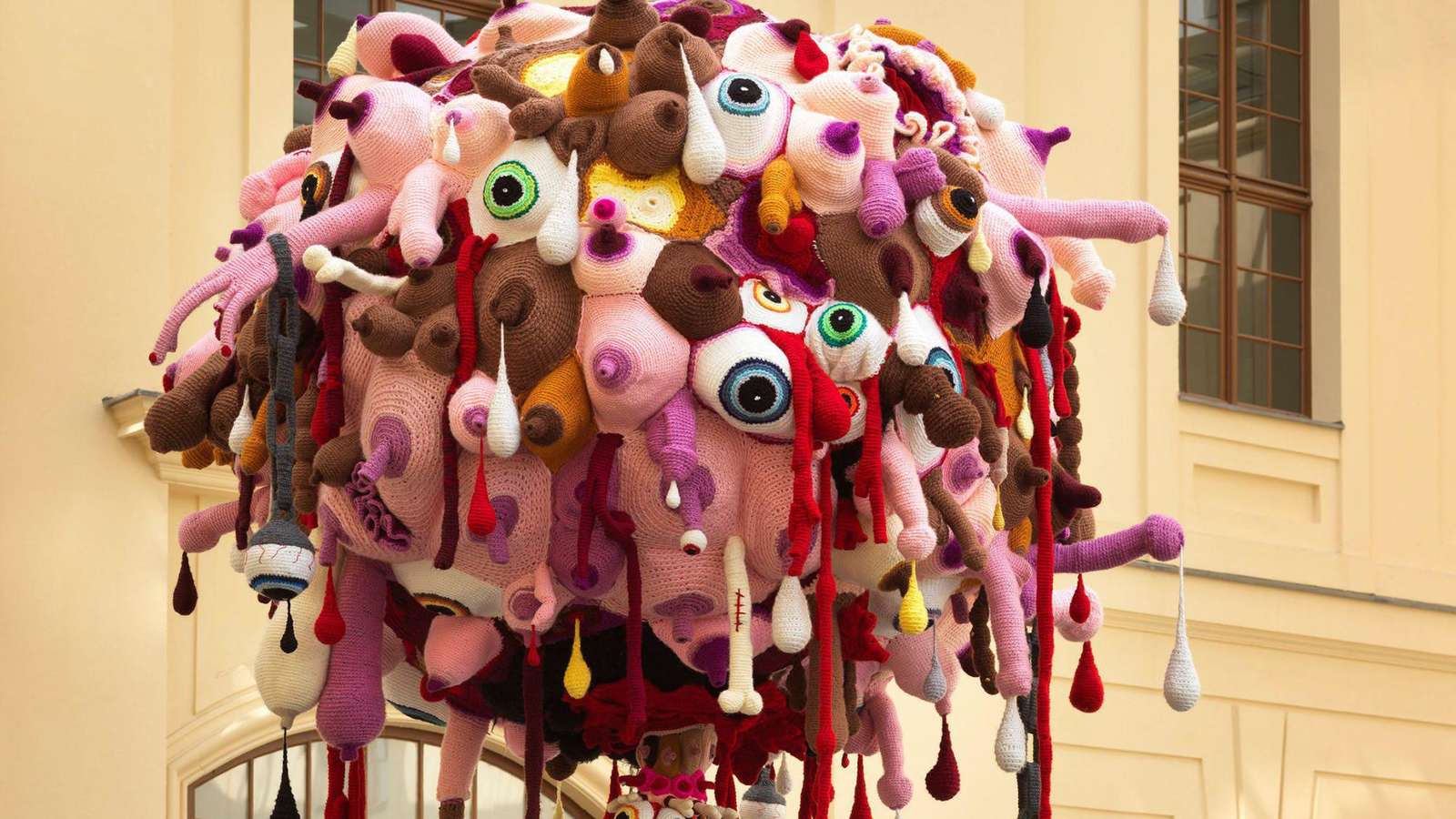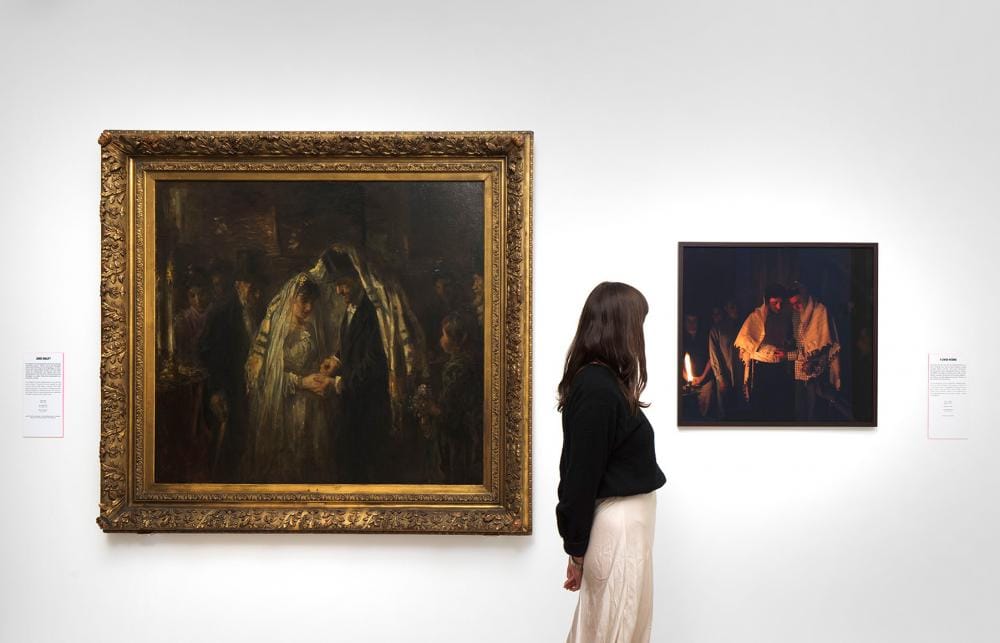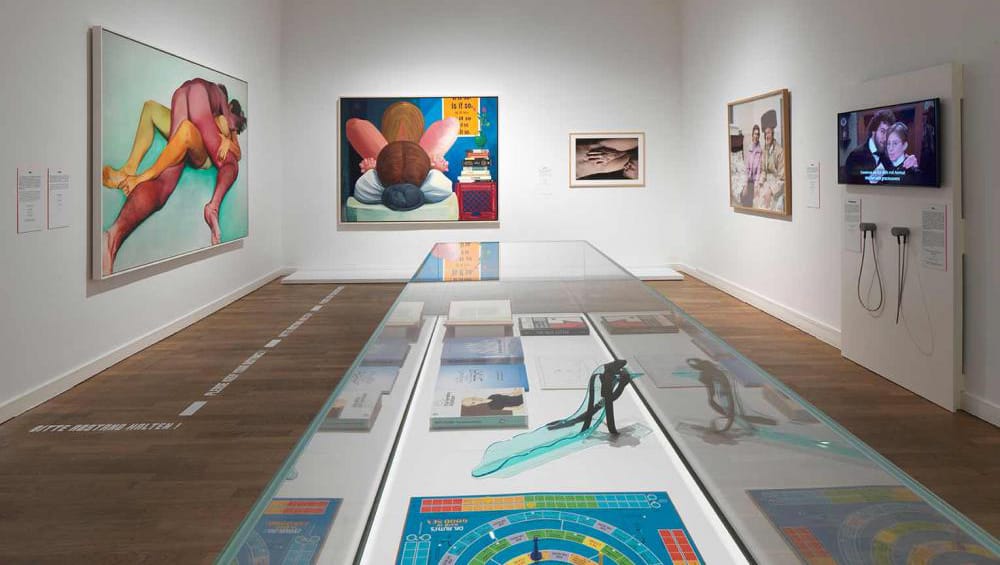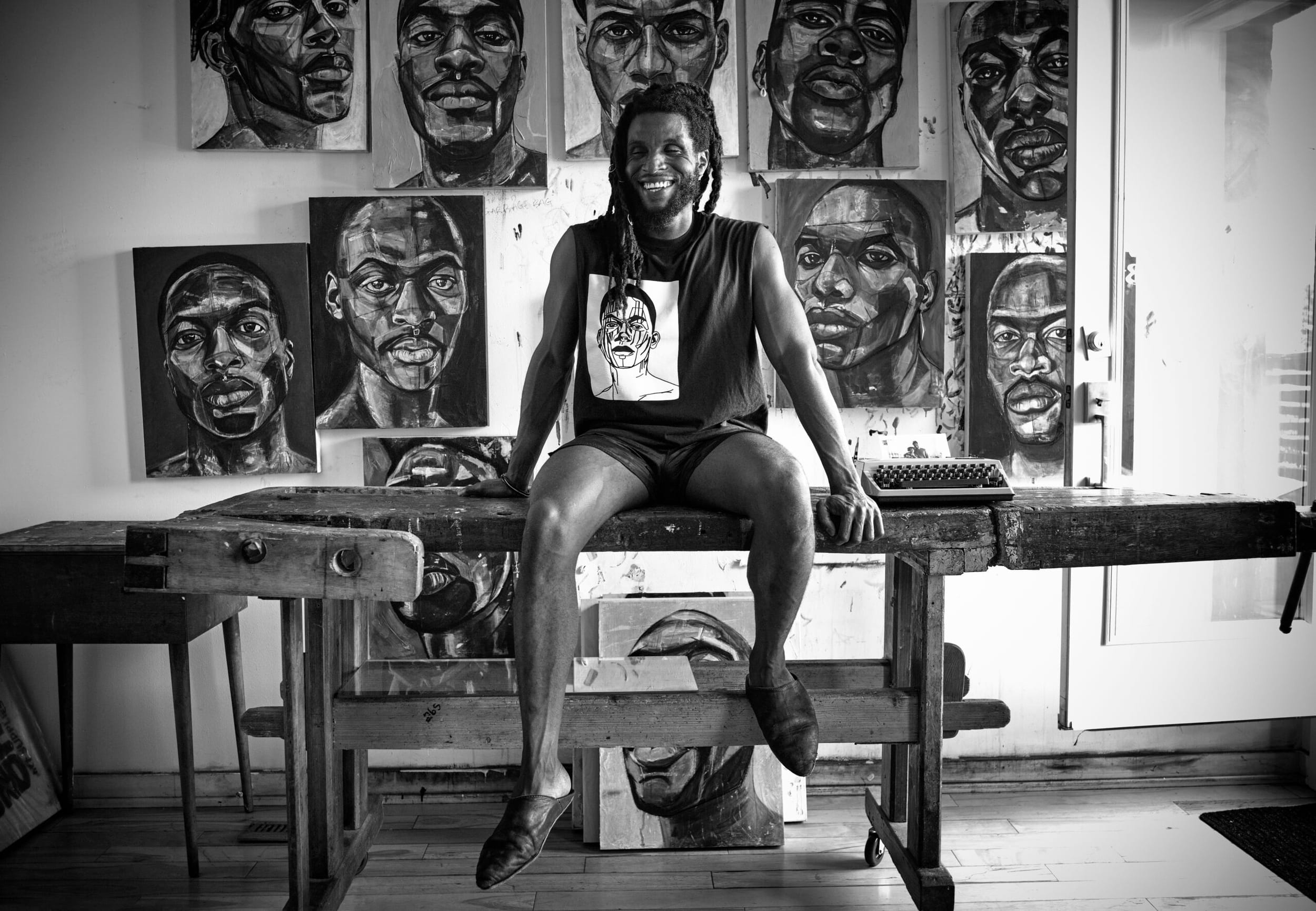The Jewish Position on Sex
Jonathan Garfinkel explores a new exhibition that attempts the sticky, contradiction-laden, and perhaps impossible task of figuring what sex means in a Jewish context, from the Mishnah to Dr. Ruth and beyond.

One thing that has always struck me about Judaism is its emphasis on a non-celibate life. Sex is to be celebrated; it’s even a commandment. Unlike a Catholic priest, rabbis are expected to wed and have children. Many years ago a much younger me explained to a gentile woman that having sex on the sabbath was considered a mitzvah—a lame attempt at a pick-up line that didn’t succeed. But the sentiment isn’t untrue. Sex is unambiguously and openly part and parcel of Jewish life.
Beyond that, I can’t claim to know many of the Talmudic rules regarding sex, apart from what I’ve seen on Shtisel and Unorthodox: Orthodox Jewish women can’t have sex during and immediately after menstruating; the commandment for a couple to have sex for the first time on the wedding night; the biblical inscription to “be fruitful and multiply” that, taken literally, results in families with a lot of children.
But this really only speaks to certain communities of Orthodox Jews, and certainly not my adult experience. What about sex for pleasure? What about Jews who identify as LGBTQ+? How is the rather patriarchal Judaism of the Torah, which explicitly prohibits masturbation and non-heterosexual sex, while framing marriage as a form of ownership that insists on procreation, to be understood in the 21st century?
The exhibition Sex: Jewish Positions, now showing at the Jewish Museum in Amsterdam, tries to embrace, explore, and embody these contradictions, reflecting in its size and scope the vastness of this task. Organized by theme—“Procreation and Pleasure”, “Desire and Control”, “Sexuality and Power”, and “Eroticism and the Divine”—this ambitious show brings together various strands of Jewish art, culture, and history, including the religious, the secular, and the joyously profane. With artifacts and artworks spanning the middle Bronze Age, the renaissance, and our contemporary moment, the show is an attempt to wrestle with what sex means in a Jewish context.
Probably an impossible task. For as any Jew knows, if you get three of us in a room you’ll have four opinions, perhaps because no rule is ever crystal clear, apart from the commandments “thou shalt not kill” and don’t forget to call your mother. Still, in its grappling with the tensions between past and present, interpretation and contradiction, Jewish Positions points to the evolutions necessary for an ancient tradition to remain relevant today.
One of the show’s three curators, Miriam Goldmann from the Jewish Museum in Berlin, puts it another way. “If you understand the attitudes towards sex in Judaism,” she tells me in an interview, “then you understand how Judaism works.” By which she means, that just as Judaism’s relationship to sex can be hard to pin down, sometimes so is Judaism itself. It’s an open conversation.
Installations like Gil Yefman’s Tumtum speak to both the elusiveness of what Goldmann describes and its capaciousness, as the Tel Aviv-born multidisciplinary artist draws on the Mishnah, the first collection of the Oral Talmud, in which the word tumtum is used to refer to people with an ambiguous sexual identity. Even in the 2nd century CE, apparently, rabbinical scholars had identified up to seven sexual identities, including the androgynous tumtum—people whose genitalia could not be distinguished as male or female. Not the sort of thing one hears about on Shtisel. If Goldmann wants us to understand what attitudes towards sex can tell us about Judaism, Yefman shatters any preconceived notion of orthodoxy with a colourful and provocative three-dimensional hanging assemblage of drooping limbs, blood, genitalia, and eyes. Everything is screaming to be seen.
As though to underscore the point about evolution and contradictions within tradition, among the first images I encountered during the exhibition’s opening run at Berlin’s Jewish Museum were two nearly identical images of marriage juxtaposed. To one side, there was the rather solemn painting Jewish Wedding from 1903 by the Dutch artist Jozef Israels. In it, a man and woman are draped beneath a chuppah, or wedding canopy, the groom slipping the ring on his bride’s index finger in the symbolic act of effecting his “acquisition”. The small group of guests around the couple are steeped in shadow.
Next to it is an image from 2008 by Jerusalem-based portrait photographer Yitzchak Woolf which nearly mirrors the composition and content from the wedding scene more than a century earlier. Featuring a gay couple, Benny and Nir, who based their wedding ceremony on the Israels painting, on the one hand it acknowledges the slowly growing acceptance of same-sex marriage within Judaism, while still hinting at its unresolved status. Notably, instead of a chuppah in Wolf’s painting the couple are being married under a more modest tallit, or prayer shawl, a reference to both a less common custom and kind of step-down in status. The display text tells us that it took a long time for Benny and Nir to find a congregation willing to marry them.

Throughout the exhibition it is often such deftly provocative juxtapositions that speak the loudest. Several items allude to the ketubbah, a Jewish marriage contract that is traditionally framed by decorative images and script. Next to a colourful, elaborately ornamented ketubbah from 18th century Padua sits A Recontextualized Ketubbah, a collage work by the late 20th century artist Gay Block, in which her black and white wedding portrait with rabbi Malka Drucker is overlaid atop a richly ornamented Italian ketubbah from two centuries earlier—expanding the frame of what marriage means, and who it includes, in the Jewish tradition. Then there’s the “Brit Ahuvim”, from 2023, conceived by American theologian Rachel Adler (2023), a progressive, egalitarian rewriting of the traditional marriage contract that excises any notions of a male groom acquiring the female bride as his property.
Parts of the show made me nostalgic for the discussions around sex and sexuality I grew up with in the 1980s, thanks to the therapist and talk show host Dr. Ruth Westheimer. As a curious teenager, I spent many a Sunday night glued to the radio as I listened to her answer callers’ questions. Is it healthy to masturbate eight times a day? Where is the clitoris located? Is the G-spot real? A German-Jewish survivor of the Holocaust, Dr. Ruth spoke with an unprecedented frankness and candour, breaking boundaries and taboos irrespective of one’s religious or cultural background. Included in the exhibition is the board game Dr. Ruth’s Game of Good Sex, which serves as an ode to her cultural and social impact as feminist, sex-positive spokesperson. To win the game, you must enter the track of “mutual pleasure.”
While I loved being reminded of Dr. Ruth’s impact on my adolescent brain, the size and scope of the exhibition could be a bit much to properly absorb, and at times I felt overwhelmed by the amount of explanatory text and contextualization required. Miriam Anzovin, an American content creator with a massive TikTok following thanks to her irreverent commentary on the Talmud, was highlighted for her celebration of Jewish sexuality in a millennial and feminist context. The art of her performance, however, felt secondary to the telling of what she does. Nonetheless, her playful Daf Yomi videos, based on the practice of daily Talmudic study, in particular her response to Ketubot 62, wherein the Talmud commands that a man is required by law to sexually please his wife, were hilarious and on point. After the show I fell down an Anzovin rabbit hole on TikTok. Her interpretation of the legend of Ashmodai, part of the series “Jewish Lore Reactions”, was particularly captivating. Think Game of Thrones meets Miranda July.
Adi Nes’ Untitled (Soldier Series) presents a homoerotic image of a shirtless Israeli soldier flexing his bicep in front of the empty desert. Challenging conventional Israeli notions of masculinity and strength, there’s something too in how the soldier’s lean, muscular body critiques the idealization of unmitigated military might, as his curling shadow flails against the green canvas of his tent.
Surprisingly, it was the series by Israeli photographer Vardi Kahana called One Family, from the “Procreation and Pleasure” section, that touched me the most. A collection of black and white images, it documents the story of Kahana’s extended family, 31 grandchildren among them, and 40 great-grandchildren. It also tells the broader history of Jewish-Israeli life. Kahana’s mother, a survivor of Auschwitz, emigrated to Palestine in 1947, with two of her sisters later joining her. (Seven other siblings perished in the Shoah). Kahana’s photographs capture the fractured geographical and ideological borders that evolved within her family, and more broadly Israeli society, over the decades since 1948. She travels from West Bank settlements to leftist kibbutzim, vastly different worlds. One family stands in front of a treehouse. Another inside a dance studio gilded by mirrors. Another by the Galilee sea.
There is nothing particularly special about what the subjects are doing. Perhaps because of the mental and geographic boundaries Kahana crosses her images stood out to me amidst the clamour of so many perspectives. There is something about the sprawling work that forces the viewer to slow down, rather than graze between the disparate other works, forcing a kind of confrontation with the profoundly human, within a distinct socio-historical context. But in the intimacy of these faces we bear witness also to the faces of those who are missing, what’s hidden from view in this story of Jewish-Israeli life. Maybe it’s the ghostly absence of any reference at all to the experience of Palestinians that upsets me. I find myself crying, without knowing why.

Unexpectedly, the exhibition did help me better understand my current life in Berlin. I first visited the city in 1999, as a young Jewish-Canadian poet and writer, en route to Poland and Ukraine to visit the shtetls of my grandparents, and make some sense out of the catastrophe of European Jewry. On a haunting tour of the newly renovated but still empty Jewish Museum designed by architect Daniel Libeskind, I remember meeting a tall, blond, and very Aryan-looking German donning a white kippah; he had just come back from a year living on a kibbutz in Israel. And out in Berlin’s streets I often slipped on the brass-plated stolperstein among the paving stones that commemorated Jews who once lived in nearby buildings, inscribed with dates of birth and locations of death: Auschwitz, Treblinka, Sobibor.
German memory culture, coupled with philo-semitism, felt both reassuring and unsettling in those days. Now German staatsrason, or state purpose—that of defending and supporting the state of Israel at any cost—has made life here much more complicated. Since October 7, the German state’s stance, coupled with the rise of the right wing AfD, has led to a divided arts community, an alienated Muslim community, and a fearful Jewish population on account of rising antisemitism.
I hadn’t approached Sex Positions as a way of seeing how me and my choices fit into some religious, political, or cultural context. Rather, I hoped to experience a world of playfulness and creativity, to meditate freely on pleasure, pain, and the intimacies of the body, rather than a world in conflict. Time away from the news of death and destruction, tailored by algorithms and delivered instantaneously to our phones.
Benyamin Reich’s Tefillin Shel Yad (2005), from his Judaica Series, spoke best to this need by using tefillin, or phylacteries, black leather boxes traditionally containing scrolls with verses from the Torah, to highlight the erotic aspects of devotion, where the ritual object is both prayer and sex toy. Perhaps these are the kinds of prayers we need to survive in these times, to remember the human and moral costs of a war with no end in sight.
The exhibition Sex: Jewish Positions runs at the Jewish Museum in Amsterdam until May 25, 2025.





